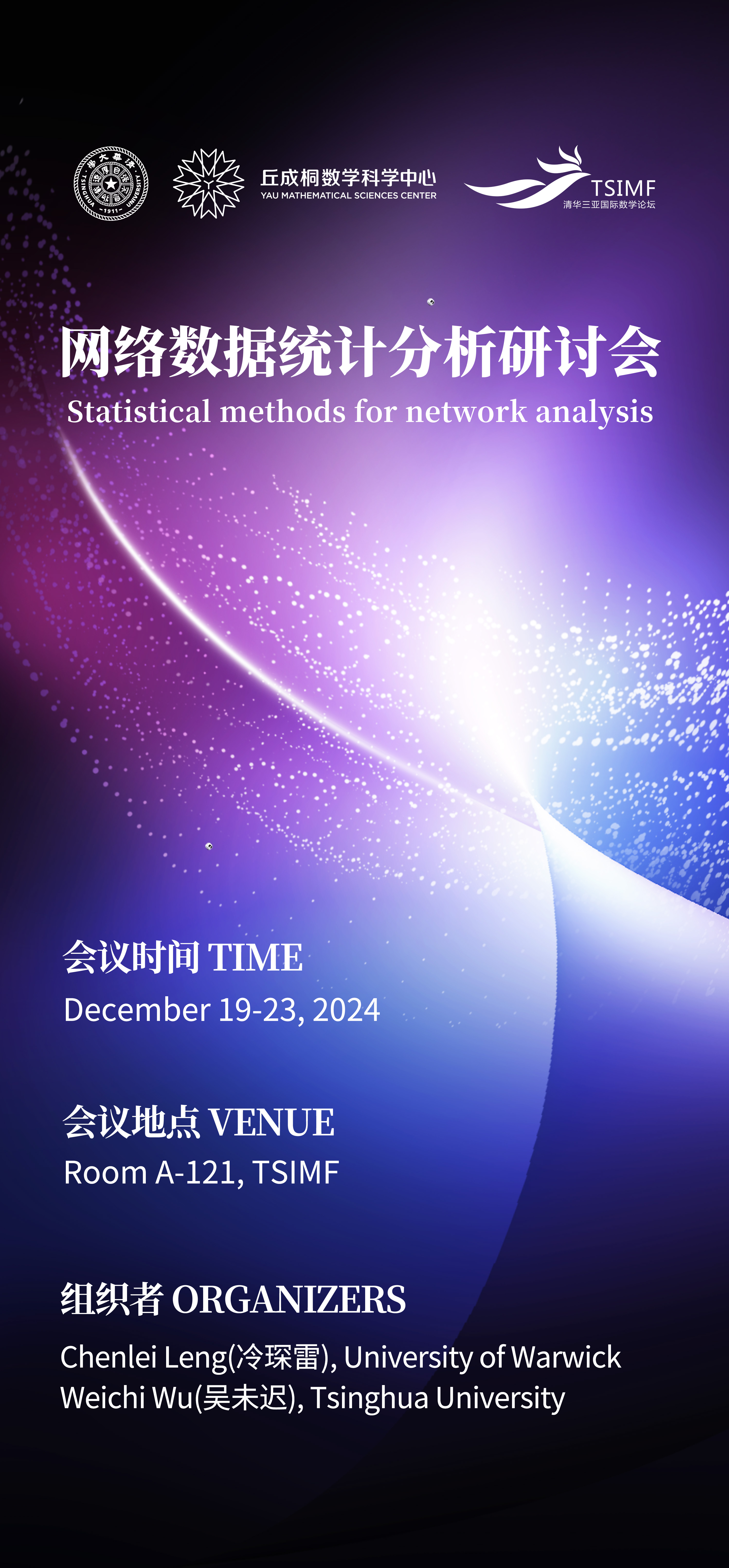会议摘要(Abstract)
近年来,随着数据类型与形式的多样化,对于复杂数据的研究吸引了越来越多学者的讨论与关注。网络数据作为一种常见的用于刻画不同个体之间属性与关系的复杂数据类型,逐渐引起了统计学,计算机科学,经济学,社会学等学科领域内学者的广泛关注。同时由于网络数据结构的复杂性,传统的数据分析方法可能无法解决网络数据分析中的问题,因此在这类数据的分析的过程中往往会产生新的统计分析方法。
现实生活中网络数据的一个重要特征是具有特定的群组结构,例如社交网络中不同的朋友圈,生态网络中不同的生物种群等等。因此,社区发现始终是网络分析中的一个重要问题。好的社区发现方法能够快速准确地找到网络数据中潜在的群组结构,从而更好地提取和利用网络数据中的信息。
另一方面,随着数据收集能力的提升,网络数据的类型也更加多样化,更复杂的网络数据也通常包含更多的信息。例如对于动态网络数据的研究能够分析网络中结构与信息随时间的变化情况,对于超图网络的建模能够更好地理解网络中三个及以上个体之间的相互关系与作用。
本次研讨会将重点关注网络数据中的社区发现,动态网络与超图网络的建模以及网络数据分析中的其他重要问题,旨在讨论网络数据分析领域最新的研究成果,促进学者之间的交流与合作。
The theme of this conference revolves around the evolving and multifaceted field of network data analysis. In recent times, the diversity of data types and formats has made the study of complex data an increasingly prominent topic within scholarly discussions and research. Network data, a complex data type commonly used to depict the attributes and relationships among different entities, has garnered extensive attention across multiple disciplines including statistics, computer science, economics, and sociology. This attention is partly due to the limitations of traditional data analysis methods in addressing the complexities inherent in network data, leading to the development of innovative statistical approaches for this purpose.
A notable feature of network data in real-world scenarios is its inherent group structures, such as the various social circles found in social networks or the different species populations in ecological networks. This aspect makes community detection a critical area in network analysis. Effective methods for community detection can identify potential group structures within network data quickly and accurately, thus improving the extraction and utilization of information from the network.
Additionally, advancements in data collection capabilities have led to a greater diversity in the types of network data available, which often contain more complex information. For example, studying dynamic network data can provide insights into how network structures and information change over time. Similarly, modeling hypergraph networks can enhance our understanding of the interactions and relationships among three or more entities in a network.
The focus of this conference will be on key areas such as community detection in network data, modeling of dynamic and hypergraph networks, and other important issues in network data analysis. The goal is to share and discuss the latest research findings in this field and to promote collaboration and exchange among scholars.
举办意义(Description of the aim)
此次会议将涵盖网络统计分析的主要领域,包括社区检测,网络数据回归分析,动态网络建模,图模型概率性质等诸多领域。
1.社区检测(community detection)
社区检测是一种在网络数据中寻找紧密连接的子群体的方法。以社交网络为例,人们受工作环境、家庭和朋友的影响,自然地倾向于形成不同的群体。通过将网络划分为不同的社区,有助于揭示网络结构中的隐藏模式和关联。社区检测在社交网络分析、生物信息学和推荐系统等领域具有着广泛的应用,是网络统计分析中最热门的领域之一。
经典的社区检测方法包括基于图分割、基于相似性度量、基于分裂和基于模块化优化等方法。近年来新的发展包括允许部分重叠的社区,动态的社区等。基于随机区块模型(Stochastic Block Model),许多学者对社区检测方法对准确度和渐近性质做了研究,例如Abbe (2017), Wang et al.(2023),Jin et al.(2023)等。此外,深度学习在社区检测中也具有潜力,例如Li et al.(2021),Sperlí(2019)等。本次会议将邀请体现社区检测方面的现代发展,讨论前沿理论和应用问题。
2.网络数据回归分析
这一领域利用回归分析来理解和预测网络中节点的连接和交互方式,这有助于研究节点属性对网络拓扑的影响程度,并可以对网络中影响力较大的节点做出识别。相关模型包括稀疏Beta模型(Chen et al., 2020),全局结构模型(Ullah et al., 2021),根节点识别模型(Crane et al.,2021)等。
3.动态网络建模
网络时间序列正变得愈发常见,这些数据中相互关联的个体会影响彼此的特征。Zhu et al.(2017)提出了网络自回归模型,将时间与节点各自的协变量联系在一起。近年来,这一领域引起了广泛的关注,相关模型包括分位数自回归模型(Zhu et al., 2019),混合自回归模型(Zhu and Pan, 2020),网络霍克斯过程(Hawkes process)模型(Fang et al.,2023),自回归网络(Jiang et al.,2023)等。此外,考虑到同质性的存在,许多学者将潜在变量也考虑在内,如McFowland and Shalizi (2023),Wu and Leng (2023)等。
变点检测是一个与网络数据密切相关的问题,在动态网络框架下,近年来有许多相关的方法和理论结果,如Wang et al.(2021), Yu et al.(2021), Li et al.(2022)等。此次会议将请到相关邻域的学者进行讨论报告,分享前沿思想和技术。
4.图模型概率性质
当网络节点数趋于无穷时,网络的局部收敛性是非常重要的问题。以优先附着(preferential attachment)网络为例,节点数趋于无穷时它会局部收敛到一个特定的树过程(Garavaglia et al., 2022)。相关的理论结果包括Banerjee et al.(2023),Hofstad(2024)等。
此外,网络的概率性质与统计推断也密切相关,如网络数据的两样本检验等,相关工作包括Maugis et al.(2020),Shao et al.(2022)等。此次会议将涵盖这一领域,邀请相关的概率统计学家进行报告,参会者将获得图模型的最新理论进展,使他们能够受到启发并推动网络统计分析的发展。
5.超图网络
常见的网络数据通常用于刻画不同节点两两之间的相互关系,超图网络则通过超边同时连接两个及以上的节点,从而能够表示多个节点之间的相互关系。这样的包含多个节点的相互关系在生活中也是十分常见的,例如生物医学中不同蛋白质之间复杂的相互关系。如何对超图网络进行合理的刻画和表述以及如何建立合理的超图网络模型是本次研讨会关注的问题。
This conference will delve into pivotal areas of network statistical analysis, focusing on community detection, regression analysis of network data, modeling of dynamic networks, understanding probabilistic properties in graph models, and exploring the complexities of hypergraph networks.
1. Community Detection.
This method identifies closely-knit subgroups within network data. For example, social networks often feature distinct groups formed around work, family, and friendships. By segmenting networks into various communities, we can uncover underlying patterns and connections. Community detection is crucial in fields like social network analysis, bioinformatics, and recommendation systems. Traditional methods include graph-based partitioning and modularity-based optimizations, while recent advances explore overlapping and dynamic communities. Notable research includes studies on the Stochastic Block Model's accuracy and properties. The conference will discuss these advancements, highlighting new theories and practical applications.
2. Network Data Regression Analysis.
This area uses regression analysis to understand and predict interactions within a network, analyzing how node attributes influence network structure and identifying key nodes. Models such as the Sparse Beta Model and Global Structure Model are notable examples. The conference will examine these models, contributing to our understanding of network relationships.
3. Dynamic Network Modeling.
As network time-series data gain prevalence, understanding how interconnected entities influence each other over time becomes crucial. Models like the network autoregressive model and Quantile Autoregressive Models have been developed to address this. The conference will also explore change-point detection within dynamic networks, a topic of growing interest, showcasing the latest methods and theories.
4. Probabilistic Properties of Graph Models.
A key focus here is the local convergence of networks as node numbers increase, exemplified by Preferential Attachment networks converging to specific tree processes. Theoretical contributions in this field include those by Banerjee et al. and Hofstad, providing insights into statistical inference in network data. The conference aims to delve into these probabilistic aspects, inviting experts to share their findings.
5. Hypergraph Networks.
Beyond conventional networks that link pairs of nodes, hypergraph networks connect multiple nodes simultaneously, enabling the representation of complex multi-node relationships. These are particularly relevant in fields like biomedicine for modeling intricate protein interactions. The seminar will focus on characterizing and modeling hypergraph networks, fostering a deeper understanding of these complex structures.

Chenlei Leng, University of Warwick
Weichi Wu, Tsinghua University